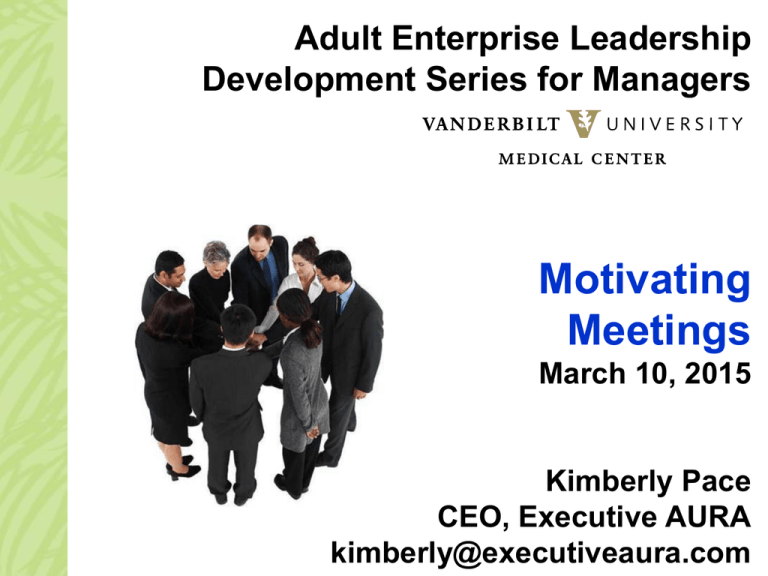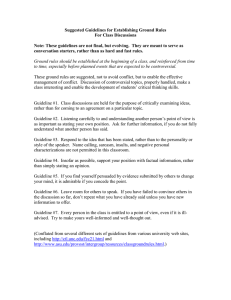Motivating Meetings Adult Enterprise Leadership Development Series for Managers
advertisement

Adult Enterprise Leadership Development Series for Managers Motivating Meetings March 10, 2015 Kimberly Pace CEO, Executive AURA kimberly@executiveaura.com Good meetings 30% Agenda/Good use of time 30% Accomplished goals/Resolved issues 23% Participation from everyone 17% Well led/Prepared Bad meetings 42% Lack of Control/Too much input/No Agenda 36% Little accomplished/no resolution-decisions 11% Negative/Arguing Good meeting leader #1 #2 #3 #4 #5 Organized/prepared/knowledgeable Engaging/positive Listens/builds consensus Manages discussion Respected/trusted Bad meeting leader #1 #2 #3 #4 Disorganized/unprepared Afraid/wimpy or too arrogant/overbearing No ability to engage participants/poor speaker No sense of humor/boring Your best leadership qualities #1 #2 #3 #4 See and hear all sides Agenda with goal/prepared Keeping discussion on point Trust/positivity/energy Levels of People Diagnose – People & Processes • Some people never see it. (They are wanderers.) • Some people see it but never pursue it on their own. (They are followers.) • Some people see it and pursue it. (They are achievers.) • Some people see it and pursue it and help others see it. (They are leaders.) Guideline 1 Reduce Role Ambiguity Leadership is about people – people can walk away or check out of the discussion. What is the role of each person in the meetings? Guideline 2 Complete Due Diligence @ Talent Acquisition 1. Pursue, challenge and leverage talent data. 2. Conduct human capital due diligence. 3. Think how new people will be integrated, their strategic fit, and what complimentary strengths they bring to the department. Guideline 3 Recognize Old Habits Die Hard Companies have well-established routines – and individuals adopt those routines as they spend time with the company – so know the history of the individuals and VUMC’s “routines.” Guideline 4 Don’t Tolerate Bad Behavior 3 common forms of harmful behavior: 1. Cliques 2. Information asymmetries 3. The sabotage of decision making Guideline 5 Practice Patience with Purpose Until systems & processes are integrated, you run a sub-optimized organization. Reinforce the overall company objective and purpose. Invest in team development. Ensure that everyone understands mission and strategy. Guideline 6 Count – and Then Celebrate Your Blessings Before the meeting (Pre-Presence) • Define purpose and outcomes • Distribute agenda • Ensure you have the right people in the room • Schedule one-on-one conversations before the meeting • Choose a dynamic location • Consider set-up and props in the room Agendas 1. Grabber 2. Warm-up phase: Clarify purpose and roles, announcements, easy to decide 3. Phase 1: Difficult issues 4. Phase 2: Discussion, not decision 5. Phase 3: Goals achieved and next steps 6. Sticker During the meeting (presence) Distribute timed agenda Start and end on time Clarify and adhere to meeting rules Create safe climate to speak up Relate personally to each person Offer enthusiastic attitude Invite contributions During the meeting (presence) • Offer thought-provoking discussions • Tap resources of the whole group • Make sure discussions related to outcomes • Use “parking lot” for topics off discussion • Utilize “Take 2” to make sure no 1 person takes over conversation • Apply “no jerks” • Speak less than 20% of the time • End with achievements and next steps After the meeting (Post-presence) • Email assignments with dates • Send minutes • Continue one-on-one conversations • Follow up on topics you said you would answer



